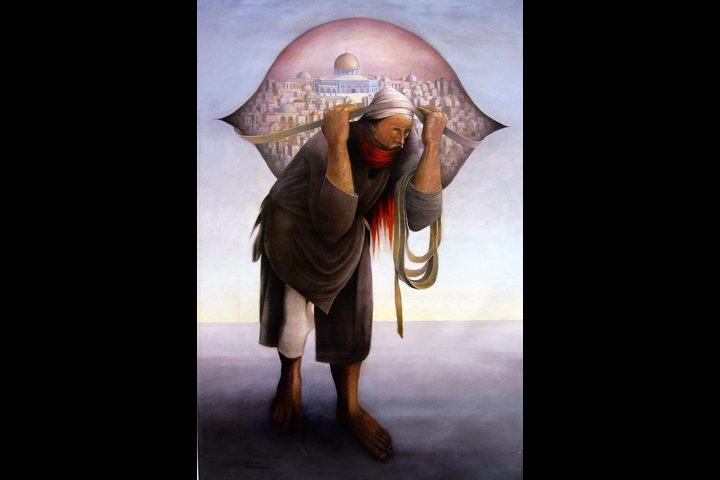In the heart of the Old City of Jerusalem in the 1970s, a scene unfolded that would inspire a powerful work of art and become an enduring symbol of the Palestinian struggle. The scene featured a skinny, elderly man, his frail frame burdened by an immense load that included the weight of Jerusalem itself.
This striking image became the catalyst for Suleiman Mansour, a Palestinian artist, to create a masterpiece known as "Camel of Hardships." This painting, now a symbol of resistance, carries the weight of a people's history, suffering, and unwavering determination.
"Camel of Hardships" is more than a work of art; it is a poignant narrative that tells the story of the Palestinian people. The canvas is a testament to the resilience, suffering, and indomitable spirit of a nation. It was created in 1973, a time when the Palestinian people were facing immense challenges, and their longing for their homeland, their identity, and their freedom was palpable.
Assmat Assad, a professor at Najah National University's art department, provides insight into the life of the artist behind "Camel of Hardships." Suleiman Mansour, a conceptual artist, was born just a year after the Nakba—an event that remains etched in the collective memory of Palestinians.
Assad explains, "Mansour's exceptional memory has inspired him and armed him with unforgettable experiences to address the Palestinian issue through his art, evoking deep feelings of sorrow and determination."
The symbolism in "Camel of Hardships" is both profound and layered.
The image of the frail porter carrying the weight of Jerusalem on his back is a powerful symbol of resistance. Jerusalem, shaped like an eye, encompasses all its intricate details, with the Dome of the Rock at its center.
Assad elaborates, "This artwork encapsulates the spirit of resistance and resilience that defined the Palestinian people during that era. It was initially known as 'Palestinian Porter' but was later renamed 'Camel of Hardships' to reflect the enduring strength of the Palestinian people."
In 1975, the painting was displayed at an art exhibition in Jerusalem, where Palestinian writer Emile Habibi came across it. Habibi, moved by the painting, gave it the name "Camel of Hardships," recognizing it as a representation of every Palestinian who carries the weight of their national concerns on their shoulders.
But the journey of "Camel of Hardships" was fraught with obstacles, much like the Palestinian struggle itself. The original painting disappeared when Mansour sent it for restoration. However, to his surprise, copies of the artwork began appearing on the walls of houses, institutions, ovens, and schools in cities and villages.
This inspired Mansour to create a second copy in 1976, which was subsequently exhibited in Jordan. The powerful imagery of "Camel of Hardships" began to spread, first in Beirut and other Arab capitals, and eventually reaching Europe and the Western world.
The story took a tragic turn in 1986 when it was reported that "Camel of Hardships" was destroyed during an American raid on Tripoli. In the face of adversity, Mansour embodied the unyielding spirit of the Palestinian people and decided to paint a third edition of his masterpiece.
He named this new edition "Camel of Hardships 3." This version, larger in size, featured a canvas belt instead of the wrecked rope and introduced a distant church alongside the Dome of the Rock.
"Camel of Hardships" stands as a testament to the resilience and determination of the Palestinian people, much like the history of Palestine itself.
Assad emphasizes, "The 'Camel of Hardships' painting is a product of the conceptual art era, a time marked by intellectual and cultural flourishing in Palestinian communities. Mansour emerged as one of the most prominent artists of this period, and his paintings became a symbol of the Palestinian cause. It has been a source of inspiration for artists, writers, and cultured individuals."
The symbolism within the painting is rich and evocative. The frail porter, toiling in Jerusalem's markets, carries burdens heavier than himself, symbolizing the Palestinian people's struggle to bear the weight of their land and identity.
He appears emaciated, pale, and exhausted, mirroring the hardships faced by the Palestinian population. As he walks an endless path, it symbolizes their alienation, diaspora, and their unyielding determination to carry their beloved city on their shoulders in defiance of their challenging reality.
The image of Jerusalem in the painting reflects the Palestinians' deep loyalty and love for their sacred city. At its center stands the Dome of the Rock, symbolizing the nation's history, culture, religion, and civilization.
"Camel of Hardships" is more than a work of art; it is a reflection of a people's history and their unwavering hope.






